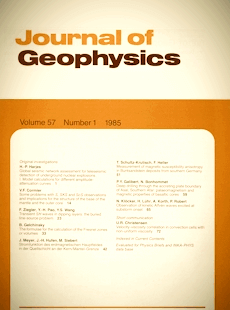Observation of kinetic Alfven waves excited at substorm onset
Article Sidebar

Vols. 1-18 (1924-1944), ISSN 0044-2801
Main Article Content
Abstract
Ground-based observations of locally confined, very intense, drifting current systems by the EISCAT magnetometer cross in correlation with GEOS-2 measurements will be explained in terms of kinetic Alfven waves. Particle and magnetic flux measurements on GEOS-2 indicate an excitation of the waves at the inner edge of the Earthward-drifting plasma sheet by resonance mode conversion from hydromagnetic surface waves. The collapsing tail-like field configuration itself is identified as the surface wave. The comparison of theoretically deduced quantities with observational results reveals a satisfactory agreement between observations and theory.
 ARK: https://n2t.net/ark:/88439/y003986
ARK: https://n2t.net/ark:/88439/y003986
Permalink: https://geophysicsjournal.com/article/293
Article Details
References
Baker, D.N., Hones, jr., E.W., Belian, R.D., Higbie, P.R., Lepping, R.P., Stauning, P. (1982) Multiple-spacecraft and correlated riometer study of magnetospheric substorm phenomena. J. Geophys. Res. 87:6121-6136
Baumjohann, W., GlaBmeier, K.-H. (1984) The transient response mechanism and Pi 2 pulsations at substorm onset. Planet. Space Sci. 31 (In press)
Fejer, J.A., Kan, J.R. (1969) A guiding centre Vlasov equation and its application to Alfven waves. J. Plasma Phys. 3:331-351
Fejer, J.A., Lee, K.F. (1967) Guided propagation of Alfven waves in the magnetosphere. J. Plasma Phys. 1:387-406
Goertz, C.K. (1983) Nonstationary coupling between the magnetosphere and ionosphere. Sixth ESA-Sympos. European rocket balloon programme. (ESA SP-183):221-228
Goertz, C.K., Boswell, R.W. (1979) Magnetosphere-ionosphere coupling. J. Geophys. Res. 84:7239-7246
Hasegawa, A. (1976) Particle acceleration by MHD surface wave and formation of aurora. J. Geophys. Res. 81:5083-5090
Hasegawa, A. (1977) Kinetic properties of Alfven waves. Proc. Indian Acad. Sci. 86A:151-174
Klocker, N. (1982) Observation of guided ULF-waves correlated with auroral particle precipitation theoretically explained by negative Landau damping. J. Geophys. 51:119-128
Korth, A., Wilken, B. (1978) New magnetic electron spectrometer with directional sensitivity for a satellite application. Rev. Sci. Instrum. 49:1435-1440
Korth, A., Kremser, G., Wilken, B. (1978) Observations of substorm associated particle-flux variations at 6 ~ L ~ 8 with GEOS-1. Space Sci. Rev. 22:501-509
Luhr, H., Kloeker, N., Thtirey, S. (1984) Ground-based observations of a very intense substorm-related pulsation event. J. Geophys. 55:41-53
Lysak, R.L., Carlson, C.W. (1981) The effect of microscopic turbulence on magnetosphere-ionosphere coupling. Geophys. Res. Lett. 8:269-272
Lysak, R.L., Dum, C.T. (1983) Dynamics of magnetosphere-ionosphere coupling including turbulent transport. J. Geophys. Res. 88:365-380
Mallinckrodt, A.J., Carlson, C.W. (1978) Relations between transverse electric fields and field-aligned currents. J. Geophys. Res. 83:1426-1432
Pashin, A.B., GlaBmeier, K.H., Baumjohann, W., Raspopov, O.M., Yahnin, A.G., Opgenoorth, H.J., Pellinen, R.J. (1982) Pi2 magnetic pulsations, auroral break-ups, and the substorm current wedge: a case study. J. Geophys. 51:223-233
Pedersen, A., Grard, R., Knott, K., Jones, D., Gonfalone, A. (1978) Measurements of quasi-static electric fields between 3 and 7 earth radii on GEOS-1. Space Sci. Rev. 22:333-346
Robert, P., Gendrin, R., Perraut, S., Roux, A., Pedersen, A. (1984) GEOS-2 identification of rapidly moving current structures in the equatorial outer mangetosphere during substorms. J. Geophys. Res. 89:819-840
Samson, J.C. (1982) Pi2 pulsations: high latitude results. Planet. Space Sci. 30:1239-1247
Shepherd, G.G., Bostrom, R., Derblom, H., Falthammar, C.-G., Gendrin, R., Kaila, K., Korth, A., Pedersen, A., Pellinen, R., Wrenn, G. (1980) Plasma and field signatures of poleward propagating auroral precipitation observed at the foot of the GEOS-2 field line. J. Geophys. Res. 85:4587-4601











